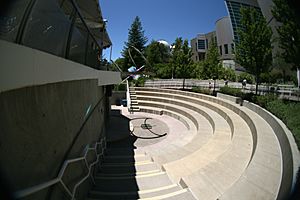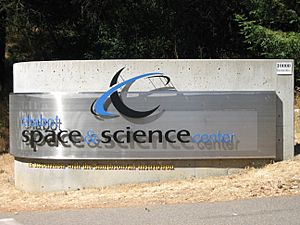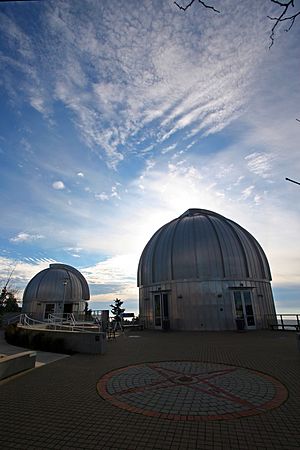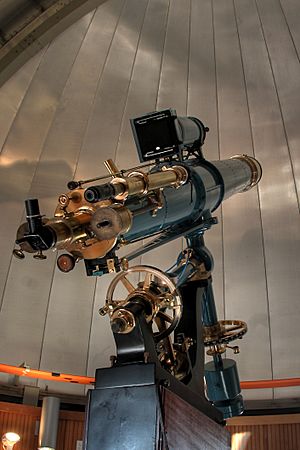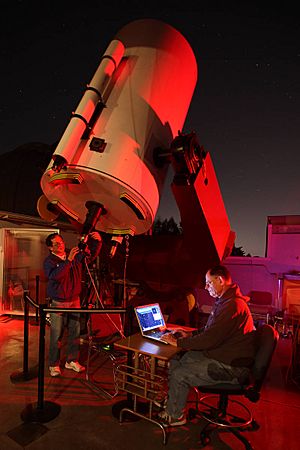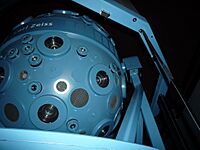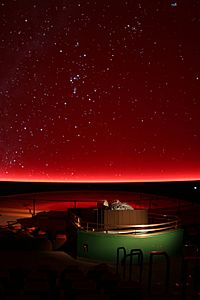Chabot Space and Science Center facts for kids
 |
|

View of the entrance of the Chabot Space and Science Center
|
|
| Lua error in Module:Location_map at line 420: attempt to index field 'wikibase' (a nil value). | |
| Established | 1883 |
|---|---|
| Location | Oakland, California, United States |
| Type | Planetarium |
The Chabot Space and Science Center in Oakland, California, is an exciting place where you can learn all about Earth and space! It has cool interactive exhibits, amazing planetariums, a big theater, and three powerful telescopes you can look through.
This center grew from a public observatory that started way back in 1883. It has taught people in the San Francisco Bay Area about astronomy and science for a long time. The center is named after Anthony Chabot, who helped start the first Oakland Observatory. Since the year 2000, the center has been next to Redwoods Regional Park. It also works with NASA, hosting the NASA Ames Visitor Center.
Contents
A Look at Chabot's History
The Chabot Space and Science Center began in 1883 as the Oakland Observatory. This was possible because Anthony Chabot gave a special gift to the City of Oakland. The first observatory was near downtown Oakland. It let people use telescopes to look at the sky.
For many years, it was also the official timekeeping station for the whole Bay Area. It used a special transit telescope to measure time very accurately.
Moving to a New Location
The observatory moved to its Mountain Boulevard spot in 1915. This move happened because of more light pollution and busy city life. In the mid-1960s, the building became much bigger. During this time, the Chabot Science Center, as it was then called, was mostly run by school staff and volunteers.
In 1977, there were worries about the building's safety during earthquakes. Because of this, public school students could no longer use the main observatory building. The observatory stayed open for everyone else, but school activities moved to other classrooms and the planetarium.
Building the Modern Center
People realized that the center needed to be fixed or moved so students could fully use it again. So, in 1989, the Chabot Observatory & Science Center was formed. This was a partnership between the City of Oakland, the Oakland Unified School District, and the East Bay Regional Park District. They also worked with the Eastbay Astronomical Society.
In 1992, the center became a nonprofit organization. Construction for the new 88,000-square-foot (8,200 m2) Science Center began in May 1998. In January 2000, before the new building opened, the organization changed its name. It became the Chabot Space & Science Center. This new name showed that the center focused on astronomy and space sciences. It also showed the many advanced programs available.
The new Chabot Space & Science Center opened on August 19, 2000. It is a 86,000-square-foot (8,000 m2), modern science and technology education center. It sits on a 13-acre (53,000 m2) site in the hills of Oakland, California.
What You Can See and Do
Besides its amazing telescopes, the Chabot Space and Science Center has many other cool things to explore:
- A "full dome digital projection system" shows different movies every day. There is also a Zeiss Universarium fiber-optic projector with weekly shows.
- The NASA Ames Visitor Center is a hands-on exhibit. It shares the exciting stories of scientific discovery from NASA’s Ames Research Center.
- Many changing exhibits are full of hands-on displays. These shows highlight interesting topics about space and science.
Powerful Telescopes at Chabot
The Chabot Space and Science Center has three observatory telescopes. All of them are open for the public to use on weekends.
- "Leah" is an 8-inch refractor telescope. It was built in 1883 by Alvan Clark & Sons and given by Anthony Chabot.
- "Rachel" is a 20-inch refractor telescope. It was made in 1914 by Warner & Swasey, with parts by John Brashear. It is the largest refractor telescope in the western United States that is regularly open to the public.
- "Nellie" is a 36-inch Cassegrain reflector telescope. It opened in August 2003 and is inside a special observatory with a rolling roof.
Quick Facts About the Observatories
- The first observatory was built in 1883, near Downtown Oakland, California.
- The second observatory was built in 1915, at Mountain Boulevard.
- The third (and current) observatory was built in 2000, at Skyline Boulevard.
More About the Telescopes
Leah
- Type: Refracting telescope
- Maker: Alvan Clark & Sons, 1883
- Size (Aperture): 8 inches
- Purpose: For public and educational use
Rachel
- Type: Refracting telescope
- Maker: Warner & Swasey / John Brashear, 1914
- Size (Aperture): 20 inches
- Purpose: For public and educational use; it was once used to track spacecraft.
Nellie
- Type: Reflecting telescope, a special kind called a classical cassegrain reflector
- Maker: Chabot Space & Science Center, 2003
- Size (Aperture): 36 inches
- Purpose: For public and educational use, and for research like tracking Near Earth Objects.
Amazing Planetariums
The Planetarium can seat 250 people under a 70-foot (21 m) wide dome. It has live shows every week, presented by an astronomer. It also shows daily pre-recorded "fulldome" shows.
- Zeiss Universarium:
The special Zeiss Universarium Mark VIII fiber-optic star projector was recently updated. It creates a very clear and deep sky with up to 9,000 stars and other objects.
- Live Show:
The Cosmos 360 show uses the planetarium's digital system to explore the night sky. This guided tour looks closely at planets, constellations, and other current events in space. The show changes to match the night sky of each season.
You can find a full list of daily shows and times on the center's planetarium page.
Galaxy Explorers Program
The Chabot Space and Science Center offers chances for local teenagers to volunteer and learn. These teens work as "explainers" on the museum floor or help with outreach trips. This program started with help from a grant called YouthALIVE!.
See also
- List of observatories
- List of largest optical refracting telescopes


